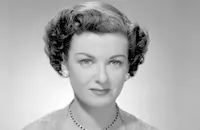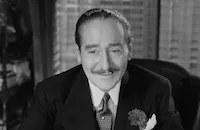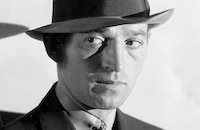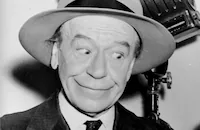The Housekeeper's Daughter

Brief Synopsis
Cast & Crew
Hal Roach
Joan Bennett
Adolphe Menjou
John Hubbard
William Gargan
George E. Stone
Film Details
Technical Specs

Synopsis
Hilda decides to quit being a gun moll and go visit her mother, who is the housekeeper for the Randall family. The Randalls go on vacation, leaving son Robert behind to embark upon a career as a reporter. Soon after, Benny, a meek flower vendor, follows showgirl Gladys Fontaine when Floyd, a mob chieftan, forces her to join him on his houseboat. Fearing for Gladys' life, Benny puts poison in a cup of coffee intended for Floyd, but Gladys drinks it instead, and Benny watches in horror as Floyd tosses the dead girl's body into the river. The next morning, Robert reads about Gladys' death and decides to cover the story, attaching himself to ace criminal reporter Deakon Maxwell and photographer Ed O'Malley. At a police interrogation session, they witness Benny confess to Gladys' murder and Robert, taking pity on the little man, befriends him. After a night of drinking on the town with Deakon and Ed, Benny suggests to the drunken Robert that he call his editor and tell him that Gladys was thrown from a houseboat. Waking up the next morning with no memory of the evening's events, Robert finds that his story has scooped the other newspapers and that he is being hailed as a hero. Robert's story leads Floyd to believe that the reporter has the goods on him, and he orders him eliminated. As the gang converges on the Randall house, Deakon and Ed are shooting fireworks from the roof and, believing that the fireworks are the sound of gun shots, the gangsters open fire. As the mobsters begin dropping dead from Benny's poisoned coffee, the police come to the rescue and Robert announces his engagement to Hilda.

Director

Hal Roach
Cast

Joan Bennett

Adolphe Menjou

John Hubbard

William Gargan

George E. Stone
Peggy Wood

Donald Meek
Marc Lawrence
Lilian Bond

Victor Mature
John Hyams
Leila Mcintyre
Luis Alberni
Rosina Galli
Tom Dugan
Gene Morgan
Brooks Benedict

Irving Bacon
Ernie Alexander
Harry Brown
Billy Engle

J. Farrell Macdonald
Stanley Andrews
Jack Raymond
Wright Kramer
Gwen Seager
Ralph Brooks
Buddy Messinger
Jack Richardson
William Newell
Charles Mcavoy
Vic Potel
Paul Burns
James Kilgannon
Al K. Hall
John Harmon
Pat Flaherty
Davison Clark
Ben Taggart
Pat O'malley
Stan Blystone
Frank O'connor
Jack Green
James Morton
Peter Lynn
Gerald Mohr
Dick French
Peter De Rey
Tony Merlo
Polly Vann Bailey
Janet Eastman
Rex Moore
John Alban
Sandra Morgan
Carlie Taylor
Eddie Arden
Joyce Bryant
Crew
Harry Black
Norbert Brodine
Bernard Carr
Gordon Douglas
Amedeo De Filippi
Lud Gluskin
Charles D. Hall
Irene
Rian James
Jack Jevne
Claude Martin
William Randall
Hal Roach
Hal Roach
Roy Seawright
W. L. Stevens
William Ziegler

Videos
Movie Clip



Film Details
Technical Specs

Articles
The Housekeeper's Daughter
In this boisterous comedy/mystery, Bennett (who resembles Hedy Lamarr here) plays Hilda, a gangster's moll who tires of being a decoy and flees the mob scene to live with her mother, Olga (Peggy Wood), the housekeeper for a wealthy family. The son of the rich folks is a young professor (John Hubbard) who stumbles onto clues about the murder of a showgirl (Lilian Bond) that could incriminate Hilda's ex-lover, and she helps crack the case. Also involved are a hard-drinking reporter (Adolphe Menjou), his photographer sidekick (William Gargan) and their excitable editor (Donald Meek). The zany finale involves dueling fireworks.
For the film's advertising, UA came up with some rhymes of its own, among them "She Couldn't Keep House! She Couldn't Cook! But What She Knew About Men Would Fill A Book!"; "She Couldn't Cook, She Couldn't Sew, But Oh How She Could So and So!"; and "Five Men Ran After The Housekeeper's Daughter...Who Treated Them Like She Hadn't Oughter!" Bennett, part of a distinguished acting family, was unamused. According to biographer Brian Kellow, she enlisted the aid of 2,600 women's clubs across the country in objecting to the crude slogans and threatening a boycott. But after the protests attracted wide publicity, they actually gave the movie a boost at the box office!
The Housekeeper's Daughter marked the film debut of Victor Mature in the small role of a gangster called Lefty. The following year Mature would create a sensation as the beefy caveman hero in One Million B.C. (1940), beginning a long career as a star.
Producer/Director: Hal Roach
Screenplay: Gordon Douglas, Rian James, from story by Donald Henderson Clarke
Cinematography: Norbert Brodine
Film Editing: William H. Ziegler
Original Music: Amedeo De Filippi, Lucien Moraweck (uncredited)
Art Direction: Charles D. Hall
Costume Design: Irene
Cast: Joan Bennett (Hilda), Adolphe Menjou (Deakon Maxwell), John Hubbard (Robert Randall), William Gargan (Ed O'Malley), George E. Stone (Benny), Peggy Wood (Olga), Donald Meek (Editor Wilson), Victor Mature (Lefty).
BW-71m.
by Roger Fristoe

The Housekeeper's Daughter
Marc Lawrence (1910-2005)
Born Max Goldsmith on February 17, 1910, in the Bronx, Lawrence had his heart set on a career in drama right out of high school. He enrolled at City College of New York to study theatre, and in 1930, he worked under famed stage actress Eva Le Gallienne. Anxious for a career in movies, Lawrence moved to Hollywood in 1932 and found work immediately as a contract player with Warner Bros. (an ideal studio for the actor since they specialized in crime dramas). He was cast as a heavy in his first film, If I Had a Million (1932). Although his first few parts were uncredited, Lawrence's roles grew more prominent: a sinister henchman in the Paul Muni vehicle in Dr. Socrates (1935); a conniving convict aiding Pat O'Brien in San Quentin (1937); a menacing thug stalking Dorothy Lamour in Johnny Apollo (1940); the shrewdly observant chauffeur in Alan Ladd's breakthrough hit This Gun For Hire (1942); and one of his most memorable roles as Ziggy, a fedora wearing mobster in the Bogart-Bacall noir classic Key Largo (1948).
Lawrence, when given the opportunity, could play against type: as the prosecuting attorney challenging Tyrone Power in Brigham Young (1940); a noble aristocrat in the Greer Garson-Walter Pidgeon period opus Blossoms in the Dust; and most impressively, as a deaf mute simpleton in the rustic drama The Shepherd of the Hills (both 1941). Better still was Lawrence's skill at comedy, where his deadpan toughness worked terrifically as a straight man against the likes of Joe E. Brown in Beware Spooks (1939); Abbott and Costello in Hit the Ice (1943); Penny Singleton in Life with Blondie (1945); and Bob Hope in My Favorite Spy (1951).
After that, Lawrence's career took a turn downward spin when he was labeled a communist sympathizer during the Hollywood witch hunts of the early '50s. He was exiled in Europe for a spell (1951-59), and when he came back, the film industry turned a blind eye to him, but television overcompensated for that. Here he played effective villains (what else?) in a series of crime caper programs: Peter Gunn, Johnny Staccato, The Untouchables, Richard Diamond, Private Detective; and eventually made a welcome return to the big screen as a returning exiled gangster in William Asher's underrated mob thriller Johnny Cool (1963).
It wasn't long before Lawrence found himself back in the fray playing in some big box-office hits over the next two decades: Diamonds Are Forever (1971), The Man with the Golden Gun (1974), Marathon Man (1976), Foul Play (1978); and The Big Easy (1987). Sure he was cast as a gangster, but nobody could play a rough and tumble mob boss with more style or conviction.
Interestingly, one of his finest performances in recent years was in television, as a severely ill old man unwilling to accept his fate in a fourth season episode of ER (1997-98). His last screen role was just two years ago, as a nimble minded VP in Looney Tunes: Back in Action (2003).
In 1991, Lawrence published a memoir about his venerable career, Long Time No See: Confessions of a Hollywood Gangster that received much critical acclaim. He has also developed a cult following due to his appearances in such offbeat items as From Dusk to Dawn and Pigs aka Daddy's Deadly Darling, the 1972 horror film he directed and starred in with his daughter Toni. He is survived by his wife, Alicia; two children from a previous marriage, Toni and Michael; and a stepdaughter Marina.
by Michael T. Toole
Marc Lawrence (1910-2005)
Quotes
Trivia
Notes
According to a pre-production news item in Hollywood Reporter, Jack Jevne and Claude Martin were to work on the screenplay of this film, but their participation in the final film has not been confirmed. Another pre-production news item notes that A. Edward Sutherland was scheduled to direct this film until Hal Roach ended his employment at the studio by buying out the remainder of his one year contract. Roach then stepped in to direct. According to another item in Hollywood Reporter, Roach wanted to borrow Spring Byington from Twentieth Century-Fox for this picture. This picture marked Victor Mature's film debut.














